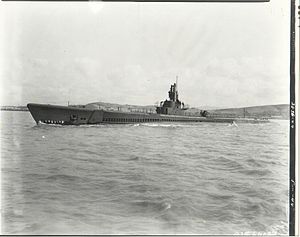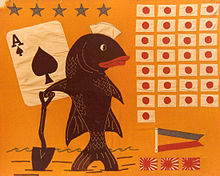- Convoy Hi-81
-
Battle of Convoy Hi-81 Part of World War II, Pacific War 
Port side view of USS Spadefish in May 1944.Date November 15–18, 1944 Location Yellow Sea Result United States victory Belligerents  United States
United States Empire of Japan
Empire of JapanCommanders and leaders  Gordon W. Underwood
Gordon W. Underwood
 Eugene B. Fluckey
Eugene B. Fluckey Tsutomu Sato
Tsutomu Sato
 Shizue Ishii
Shizue IshiiStrength Sea:
6 submarines
Air:
1 B-29 bomberSea:
2 escort carriers
1 seaplane tender
1 destroyer
7 escort ships
1 submarine chaser
3 landing ships
5 oilers
Air:
27 B5N torpedo bombersCasualties and losses none ~6,600 killed
2 escort carriers sunk
1 submarine chaser sunk
1 landing ship sunk1st Kalinga-Apayao – Shinyo Maru Incident – Leyte – Leyte Gulf – Ormoc Bay – Convoy HI-81 – Mindoro – Lingayen Gulf – Luzon – Northern Luzon – Ilocos Norte and Ilocos Sur – Baguio – Mountain Province – Bessang Pass – Mayoyao Ridge – 2nd Kalinga-Apayao – Kirang Pass – Central Luzon – Nueva Ecija – Pampanga – Tarlac – Cabanatuan – San Ildefonso – Bataan – Zambales –Manila – Corregidor – Southern Luzon – Rizal– Laguna – Cavite – Batangas – Tayabas – Los Baños – Bicol – Camarines– Lubang Island – Palawan – Visayas – Panay – Romblion – Simara – Negros – Cebu – Daanbantayan – Banatayan Island – Bohol – Mindanao – Agusan – Bukidnon – Cotabato – Cotabato and Maguindanao – Northern Cotabato – Southern Cotabato – Davao – Lanao – Maguindanao – Action of 24 July 1945 – Misamis Occidental and Misamis Oriental – Surigao – Zamboanga
Convoy Hi-81 (ヒ-81) was the designation for a fleet of Japanese transports that carried soldiers bound for Singapore and the Philippines during World War II. The transports were escorted by a large force of surface combatants including the escort carriers Shinyo and Akitsu Maru which were sunk in the Yellow Sea by American submarines. Over the course of a four day convoy battle in November 1944 nearly 7,000 Japanese were killed in action while the Americans sustained no casualties.[1]Contents
Background
Convoy Hi-81 was under the command of Rear Admiral Tsutomu Sato of the Eighth Escort Fleet in the escort ship Etorofu. Shinyo was commanded by Captain Shizue Ishii and the Akitsu Maru was actually serving as an aircraft ferry in the convoy. The other Japanese vessels known to have taken part in the mission was the seaplane tender destroyer submarine chaser oilers, Toa Maru, landing ships, Shinshu Maru, Imperial Japanese Army 23rd Division from Manchuria and were directed to separate from the main convoy at Mako and reinforce the Japanese army engaged in the Philippines Campaign. The rest of the convoy would then continue on to Singapore.[2]
Battle of Convoy HI-81
Convoy Hi-81 left Imari Bay, Japan on November 14, 1944. Rear Admiral Sato led his fleet southwest into the Yellow Sea so as to travel south along the occupied Chinese coast and then that of occupied French Indochina. After stopping for the night in Ukishima Channel, off the Gotō Islands, Hi-81 proceeded on but soon came under attack. United States Navy code breakers had informed Vice Admiral Charles A. Lockwood of the convoy only a few days prior to November 14 and he sent two submarine "wolfpacks" to the Yellow Sea. One was under Commander Gordon W. Underwood and the other under Commander Charles E. Loughlin. Underwood's pack included his boat, the USS Spadefish, the Peto and the Sunfish. The other three submarines were Loughlin's Queenfish, the Picuda and Barb.
Commander Loughlin's pack was the first to make contact with the Japanese. At about 11:50 am on November 15, the Queenfish was lined up for a torpedo attack on the carrier Akitsu Maru and six minutes later the aircraft carrier was hit by two torpedoes.[3] The torpedoes had hit aft and amidship on the port side, detonating the magazine and causing the vessel to keel over and sink in three minutes at position 33-17'N, 32-00'E. The attack killed 2,046 men. In response Captain Ishii launched some of his twenty-seven depth charge-equipped Nakajima B5N torpedo bombers to search for the Queenfish but she got away. The USS Barb, under Lieutenant Commander Eugene B. Fluckey, is credited with making an unsuccessful attack the same on Junyo though she was not part of Convoy Hi-81 and was in company with three other ships, one a cruiser. Because of this some American accounts cite Junyo as having been sunk.[4]
After the sinking of Akitsu Maru, on November 16 Rear Admiral Tsutomu headed for Strange Island off the coast of Korea to shelter there for the day. Meanwhile at Moji, Convoy Mi-27 (ミ-27) left port with orders to catch up with Convoy Hi-81 and remain near it at all times. Mi-27 included five escorts and eight transports led by Shushan Islands near Shanghai.[5]
At 12:15 one American Boeing B-29 Superfortress was spotted at position 34-08'N, 125-39'E. It dropped a bomb on the convoy but missed and the aircraft was chased away by torpedo bombers from the Shinyo. The B-29 reported the convoy's position to command which helped coordinate submarine attacks. Several hours later at 4:15 pm the landing ship Mayasan Maru exploded directly in front of the Shinyo just as Captain Ishii was landing his last air patrol for the day. It had been hit by at least one torpedo from USS Picuda. Mayasan sank with a loss of 3,437 men killed, most of whom were soldiers. Almost twelve hours later 200 kilometers off Saishu Island, Spadefish surfaced and attacked the Shinyo with six torpedoes. Four struck the carrier on the starboard at 11:03 pm, and it caught fire. At least 1,130 Japanese sailors went down with their ship; only about seventy survived, including Ishii. Kashi immediately dropped several depth charges where the Spadefish was thought to be. An oil slick and other debris eventually made the Japanese believe they had sunk Spadefish so the Kashi broke off the engagement, but Spadefish had escaped apparently without serious damage. Only minor cracks were reported to have appeared on the submarine after the alleged "sinking" by Kashi. [6]
Commander Underwood surfaced an hour later for another attack and as soon as his ship was out of the water the submarine chaser No. 156 was spotted. Spadefish fired four torpedoes; three of them hit the little chaser and it was completely destroyed after the initial explosion with all hands. Commander Underwood then submerged again.[7] The Japanese were unaware that the Shinyo had been sunk and that men were in the water until sometime after 2:20 am on November 18 when the commander of Convoy Mi-27 ordered the CD 61 to locate and assist the Shinyo. The Tsushima was also nearby and at 4:26 am her commander reported having sunk an enemy submarine with fifteen depth charges due to the sighting of an oil slick. It later proved to be an inconclusive contact. The Americans had sunk around 40,000 tons altogether.[8]
Aftermath
Due to the sinking of four ships and the loss of thousands of men, Admiral Sato stopped the convoy in Raffle's Island anchorage near Shanghai to wait for his escorts to finish their rescue operations. It wasn't until November 21 when convoy headed for Mako which they reached two days later. After that the Japanese fleet split in two, one half sailed for Singapore and the other for Luzon. The portion sent to the Philippines arrived at Manila on December 2 with much of Mi-27 and the other portion arrived in Singapore on December 4.[9][10]
References
- ^ http://www.combinedfleet.com/Kiyokawa%20Maru_t.htm
- ^ Morison pg. 409
- ^ http://www.combinedfleet.com/Shinshu_t.htm
- ^ http://www.wrecksite.eu/wreck.aspx?57663
- ^ http://www.combinedfleet.com/Shinyo.htm
- ^ http://www.combinedfleet.com/Kiyokawa%20Maru_t.htm
- ^ http://wikimapia.org/14477749/Wreck-of-HIJMS-Submarine-Chaser-No-156
- ^ http://www.combinedfleet.com/HashidateM_t.htm
- ^ http://www.combinedfleet.com/Shinshu_t.htm
- ^ http://www.combinedfleet.com/HashidateM_t.htm
- Morison, Samuel E. (2002). History of United States Naval Operations in World War II. Vol. 12: Leyte, June 1944-January 1945. University of Illinois Press. ISBN 0252070631.
Categories:- Naval battles of World War II involving the United States
- Naval battles of World War II involving Japan
- Maritime incidents in 1944
- 1944 in Asia
- Naval operations and battles
- World War II
- Convoys of World War II
Wikimedia Foundation. 2010.



